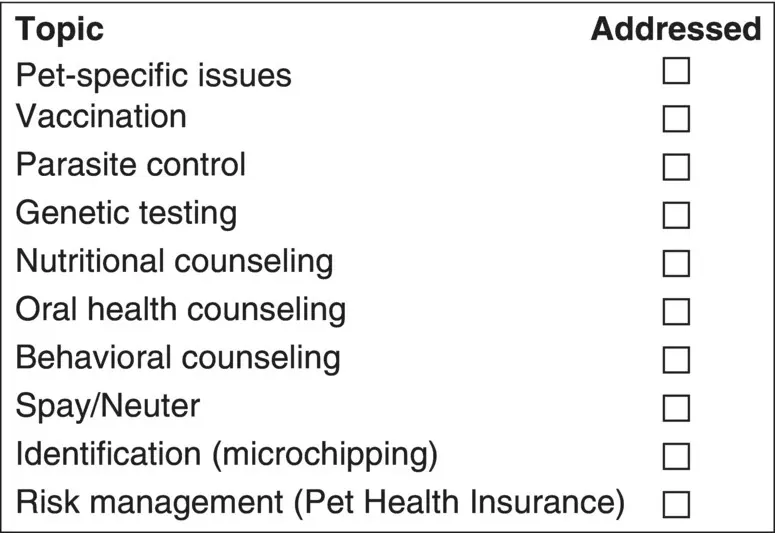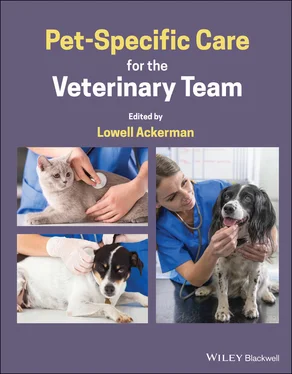It is important to understand how early detection can influence future actions. An animal that is prone to cardiomyopathy based on genetic testing, family history or breed predisposition will potentially need regular cardiac monitoring, periodic radiographs, laboratory testing, and perhaps echocardiography, all before the condition ever becomes clinical. Once it becomes clinical, there will be pharmacological and dietary intervention, likely for the remainder of the pet's life. The client will also be more likely to want to comply if they have some documentation of susceptibility through DNA testing.
Checklists have proven to be very beneficial in human medicine, where they have helped reduce medical errors, improved patient safety, enhanced teamwork, and ensured that steps were not missed (see 2.4Checklists in Veterinary Practice). Without mandatory adverse event reporting, or morbidity and mortality investigations, it is difficult to tell how often medical mistakes occur in animals (see 8.14Appropriate Handling of Medical Errors).
Checklists can also be used for more basic functions, such as history taking, presurgical and postsurgical checks, and even to ensure that certain topics are addressed in client educations ( Figure 3.4.1).

Figure 3.4.1 Topics to be addressed in puppy/kitten client discussions.
3.4.8 Predicting Outcomes
Most traits/phenes recognized in veterinary practice, and those that cause the most problems, do not seem to fit neatly into Mendelian patterns of inheritance. When phenes such as hip dysplasia, allergies, epilepsy, diabetes mellitus, glaucoma, and colitis are considered, no easy answers are forthcoming. If the problem is presumed likely to be caused by more than one gene, it is labeled polygenic but most of the time, it is impossible to prove this without genotype testing. If a condition such as epilepsy is seen, which might affect more than one member of a breed line, it might be described as familial without knowing precisely how the trait is passed in that family. When a disorder appears to be more common in some breeds than in others, we call this a breed predisposition . Once again, in most instances the exact mode of inheritance is not known.
This lack of specificity is difficult to reconcile with a desire to predict outcomes. Nearly everyone believes that German shepherd dogs are prone to hip dysplasia. We might say that the German shepherd dog has a breed predisposition or predilection for hip dysplasia. Yet, German shepherd dogs are not necessarily one of the breeds most commonly afflicted with the disorder, especially when their popularity is taken into account in terms of relative risk.
Whenever possible, risk should include a correction for a breed's prevalence in the population sampled. For example, if we were to run a hip dysplasia screening clinic and find that we had eight German shepherd dogs and four St Bernards with hip dysplasia, we might conclude that German shepherds have a higher prevalence of the problem. When these numbers are compared with the prevalence of each breed in our clinic population, however, the prevalence of hip dysplasia in St Bernards might turn out to be more than twice that in German shepherds. Because our hospital has many more German shepherd dogs, they would naturally account for a larger number of affected individuals. For many conditions, the prevalence might be high in mixed‐breed dogs (mutts) and cats (moggies), just because they represent the largest segment of a hospital population.
As a fictitious example, let's say we have a clinic population of 10 000 dogs, and when we review our medical records, we see that we have diagnosed 43 cases of follicular dysplasia over the past five years. Of these, 27 cases were seen in mutts, 11 in Chinese shar pei, and five in Irish water spaniels. In this hypothetical situation, which breed has the highest prevalence of follicular dysplasia? We cannot know until we see how the hospital population breaks down by breed. Of the dogs in the practice, 3723 are mutts, 89 are Chinese shar pei, and 12 are Irish water spaniels. According to our study, then, the condition is really seen in fewer than 1% of mutts, more than 12% of Chinese shar peis, and more than 40% of Irish water spaniels. The lesson is that, without accounting for breed numbers in a population, we could easily draw inaccurate conclusions (see 2.3Prevalence and Incidence).
Relative risk, accounting for the prevalence of issues (events) in a specified population, is a reflection of probability. Also used is an odds ratio, wherein numbers greater than 1 represent increased risk and numbers lower than 1 represent decreased risk. Thus, a canine breed with an odds ratio of 4 has four times the risk of the general canine population of developing a specific condition. For the sake of accuracy, relative risk and odds ratios are not really synonymous. Relative risk is the ratio of two probabilities, the probability (risk) of an event in a select group over the probability (risk) of an event in the control group; the odds ratio is a ratio of two odds, the odds of an event in the select group over the odds of an event in the control group. Even with odds ratios and relative risk, breed predisposition is only a rough guide to disease prevalence. As long as individual breeders decide which qualities they wish to emphasize in their matings, overall breed statistics may not tell us much.
Finally, genetic and congenital abnormalities should be differentiated. The term congenital merely implies that a trait was present at birth. It does not mean that the disorder is heritable.
Sometimes the magnitude of a heritable problem is not immediately obvious. It can be brought more sharply into focus with something called the Hardy–Weinberg law . This law helps to predict genotype frequencies with a simple algebraic formula, where p 2is the frequency of the homozygous dominant gene pairing, 2 pq is for heterozygotes, and q 2is the frequency of the homozygous recessive gene pairing, with the individual gene frequencies, p + q, equaling 1. The Hardy–Weinberg law applies as long as no mutation (allelic changes), migration (“new blood”), or active selection for a trait occurs. Although the Hardy–Weinberg law is very useful in canine genetics, it must be remembered that dog breeding invalidates some of the basic tenets of the law because matings do not occur randomly or without selection, the way they might in nature. Also, the population is rarely in equilibrium because breeders often bring in breeding animals from outside the local population. As such, gene frequencies predicted by the Hardy–Weinberg law may not be completely accurate. Still, much useful information is provided.
Let's examine this with the American car‐chasing terrier (ACCT) and the prevalence of an autosomal recessive trait, von Willebrand disease, in this breed. Although the genetic mutation associated with von Willebrand disease has been determined in many breeds, it has not yet been characterized in the ACCT, but pedigree analysis suggests that it is autosomal recessive in nature. Because von Willebrand disease in the ACCT is autosomal recessive, it is difficult to distinguish between the homozygous dominant and the heterozygote; von Willebrand factor testing does not convincingly differentiate the two in this breed, and DNA mutation testing is not yet available. The only phenotype that can conclusively be demonstrated is the homozygous recessive, those affected with von Willebrand disease.
Читать дальше













